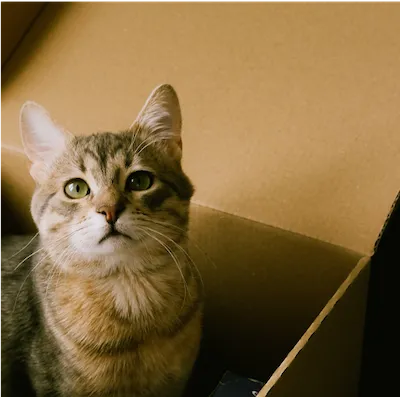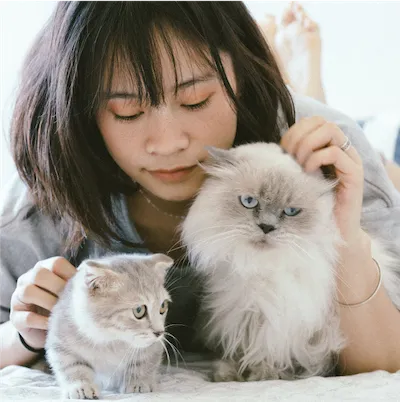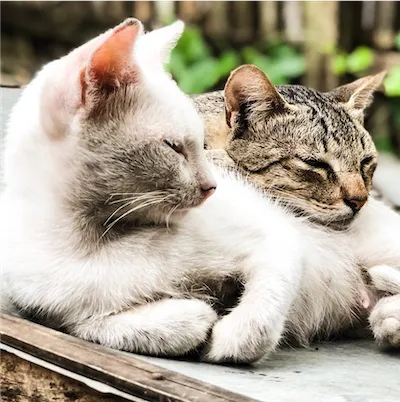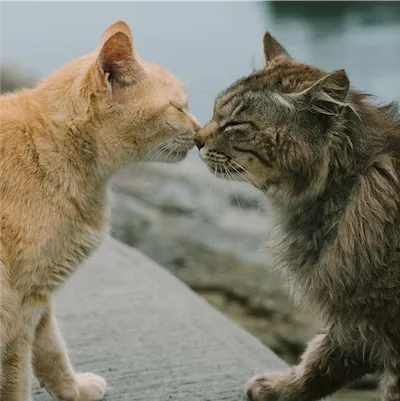Cats, Dogs, Horses, Small Pets, Birds, Poultry & Reptile
(How to Use with Fish is below)
read our cat testimonials & articles for
Whisker Wisdom

12 Tips for Moving with a Cat-A Basic Guide
12 Tips for Moving with a Cat
Moving to a new home can be an exciting yet stressful experience for both you and your cat. Cats are creatures of habit and can become anxious or disoriented when faced with changes to their environment. However, with careful planning and preparation, you can help ease the transition and ensure a smooth move for your feline friend. Here are twelve essential tips to consider when moving with your cat.
Prepare in Advance
Start preparing for the move well in advance to minimize stress for both you and your cat. Gather necessary supplies such as carriers, food, water bowls, litter boxes, and familiar bedding. Consider packing a separate "moving day" bag with essential items for your cat, including food, medications, toys, and comfort items.
Maintain Routine
Cats thrive on routine, so try to maintain their regular feeding, play, and bedtime schedules as much as possible during the moving process. Keep their belongings, such as litter boxes and scratching posts, in familiar locations until the last minute to provide a sense of continuity.
Gradually Introduce Changes
Introduce changes gradually to help your cat acclimate to the upcoming move. Start by bringing moving boxes into your home several weeks before the move to familiarize your cat with their presence. Allow your cat to explore and investigate the boxes at its own pace.
Create a Safe Space
Designate a quiet and secure room in your current home where your cat can stay during the moving process. Place its food, water, litter box, and bedding in this room and keep the door closed to prevent escape. This safe space will provide comfort and stability amidst the chaos of moving day.
Use a Comforting Scent
Familiar scents can provide a sense of security for your cat during the move. Place items with familiar scents, such as bedding or clothing that smells like you, in your cat's carrier and safe space. You can also use synthetic pheromone sprays or diffusers to help calm your cat's nerves.
Secure Transportation
Ensure your cat's safety during transit by using a secure and well-ventilated carrier. Familiarize your cat with the carrier in the days leading up to the move by leaving it open with comfortable bedding inside. Consider covering the carrier with a blanket to create a cozy and den-like environment.
Plan for Travel
Ensure your cat's safety during transit by using a secure and well-ventilated carrier. Familiarize your cat with the carrier in the days leading up to the move by leaving it open with comfortable bedding inside. Consider covering the carrier with a blanket to create a cozy and den-like environment.
Settle in Gradually
Upon arrival at your new home, allow your cat to explore and adjust to its new surroundings at its own pace. Start by confining your cat to a single room, such as a bedroom or bathroom, with its familiar belongings. Gradually introduce other areas of the house as your cat becomes more comfortable.
Maintain a Calm Environment
Upon arrival at your new home, allow your cat to explore and adjust to its new surroundings at its own pace. Start by confining your cat to a single room, such as a bedroom or bathroom, with its familiar belongings. Gradually introduce other areas of the house as your cat becomes more comfortable.
Update Identification
Ensure your cat's identification tags and microchip information are up to date with your new address and contact information. This will help ensure a swift reunion in the unlikely event that your cat becomes lost during the move.
Monitor Behavior and Health
Keep a close eye on your cat's behavior and health in the days following the move. Look out for signs of stress, such as hiding, loss of appetite, or excessive vocalization. If you notice any concerning symptoms, consult your veterinarian for advice and guidance.Before adopting a rescue cat, take the time to research local shelters and rescue organizations. Visit shelters to meet potential feline companions and inquire about their history, temperament, and any special needs they may have. Many rescue cats are already spayed or neutered, vaccinated, and microchipped, making the adoption process easier for first-time owners.
Establish New Routines
Once your cat has settled into its new home, gradually establish new routines and boundaries. Introduce outdoor access if appropriate, set up designated feeding and sleeping areas, and continue to provide mental and physical stimulation through play and enrichment activities.
In conclusion, moving with a cat may present its challenges, but with careful planning, patience, and consideration for your feline companion's well-being, you can make the transition a positive experience for both of you. By preparing in advance, maintaining routines, and creating a safe and comforting environment throughout the moving process, you can help alleviate stress and anxiety for your cat.
Remember to be patient and understanding as your cat adjusts to its new surroundings. Every cat will react differently to a move, and some may require more time and support than others. Provide plenty of reassurance, love, and attention to help your cat feel secure and settled in its new home.
As you settle into your new abode, take the time to establish new routines and boundaries for your cat. Introduce outdoor access if appropriate, set up designated feeding and sleeping areas, and continue to provide mental and physical stimulation through play and enrichment activities.
Above all, cherish the special bond you share with your feline friend and celebrate the journey of creating new memories together in your new home. With patience, love, and understanding, you and your cat can navigate the move with ease and embark on an exciting new chapter in your lives. Here's to many happy adventures in your new home!


before-and-after videos


Before and After Videos
Purr-fect Serenity: Before and After Cat Videos
Magical Before & After videos!
How to Tame a Feral Cat
Supported by Calm Animal Solutions Custom Goal Statement
Take a look at the affection-seeking interactions!
before
3-weeks after


TESTIMONIALS


TESTIMONIALS


TESTIMONIALS
cat chronicles
New Kitten Tolerated by Older cats
Mother cat kinder to grown daughter cat
cats playing again after loss of main caretaker

GOAL:
Harmony Amongst the Cats

GOAL:
Kinder Cat Interactions

GOAL:
Enjoy Life Again
I had to put my kitten in a separate room when I left the house because the older cats hiss and bat at her.
Two days later:
I felt comfortable leaving the kitten with the older cats when I ran an errand. When I returned they were all sitting peacefully on the same bed!
— SN
Louisa was a great mom to Florence when she was a kitten, but became hostile towards her as she grew older.
One week later:
I noticed Louisa allowing Florence to sit closer to her on the window ledge, as they watched the birds.
Two weeks later:
Louisa and Florence are taking turns grooming each other!
— FP
After my partner passed from an illness, our cats became skittish and hid under different beds.
Three days later:
The cats are rambunctious and playing with each other again. They seem so happy to be around each other.
— HT
new kitten tolerated by older cats

GOAL:
Harmony Amongst the Cats
I have to put my kitten in a separate room when I leave the house because the older cats hiss and bat at her.
Two days later:
I felt comfortable leaving the kitten with the older cats when I ran an errand. When I returned they were all sitting peacefully on the same bed!
— SN
Mother cat kinder to grown daughter cat

GOAL:
Kinder Cat Interactions
Louisa was a great mom to Florence when she was a kitten, but became hostile towards her as she grew older.
One week later:
I noticed Louisa allowing Florence to sit closer to her on the window ledge, as they watched the birds.
Two weeks later:
Louisa and Florence are taking turns grooming each other!
— FP
cats playing again after loss of main caretaker

GOAL:
Enjoy Life Again
After my partner passed from an illness, our cats became skittish and hid under different beds.
Three days later:
The cats are rambunctious and playing with each other again. They seem so happy to be around each other.
— HT
A Trained Animal Communicator Connects with Your Pet
With every order, a trained animal communicator connects with your pet to choose the right blend of flower essences
(e.g. Bach Flower Essences) for calming their anxiety. Custom blended flower essences are natural pet calming products.






Calm Animal Solutions
Calm Animal Solutions offers customized, natural remedies for dog anxiety, and are calming for cats. Plus, we create blends for horses, small animal pets, birds, poultry, reptiles, and fish.
#CalmAnimalSolutions
on Instagram.
©2024, Catherine Winfree. All rights reserved.
Mandatory FDA Notice: The statements made regarding Calm Animal Solutions have not been evaluated by the Food and Drug Administration. These products are not intended to diagnose, treat, cure, or prevent any animal disease. Although the ingredients in Calm Animal Solutions are generally regarded as safe, you are encouraged to consult your veterinary before using any essence product (such as Bach Flower Essences, for example).
A Trained Animal Communicator Connects with Your Pet
With every order, a trained animal communicator connects with your pet to choose the right blend of flower essences (e.g. Bach Flower Essences) for calming their anxiety. Custom blended flower essences are natural pet calming products.





Mandatory FDA Notice: The statements made regarding Calm Animal Solutions have not been evaluated by the Food and Drug Administration. These products are not intended to diagnose, treat, cure, or prevent any animal disease. Although the ingredients in Calm Animal Solutions are generally regarded as safe, you are encouraged to consult your veterinary before using any essence product.

Home | Contact | Terms | Privacy Policy | About Catherine
©2024, Catherine Winfree. All rights reserved.


